D-Day 80 special exhibition
To commemorate the 80th anniversary of the D-Day landings, we collaborated with award-winning photographer Richard Cannon to capture the portraits of 16 veterans who served in Normandy and now receive our life-changing support.
The portraits have been overlaid on photographs taken either on D-Day or during the Second World War that are relevant to the veterans' time in service. These photographs show these veterans, who changed the course of history, transported back to this historic period, providing a glimpse of what they would have experienced.
D-Day only succeeded because of the commitment of so many, in a variety of roles, risking their lives for our freedom. We are honoured to share their portraits and stories.
Alongside each photograph, you can read a detailed image description of the portrait and find out more about the veteran's story.
“I wanted to find a way to photograph these veterans that not only encapsulated their time during D-Day but also show that they have lived long and full lives. So I started to think of a way to transport who they are now to the history of what happened 80 years ago."

Photographer
By sea: Meet our D-Day Navy veterans
Joe's ship: refuge in the defence of Mulberry harbour
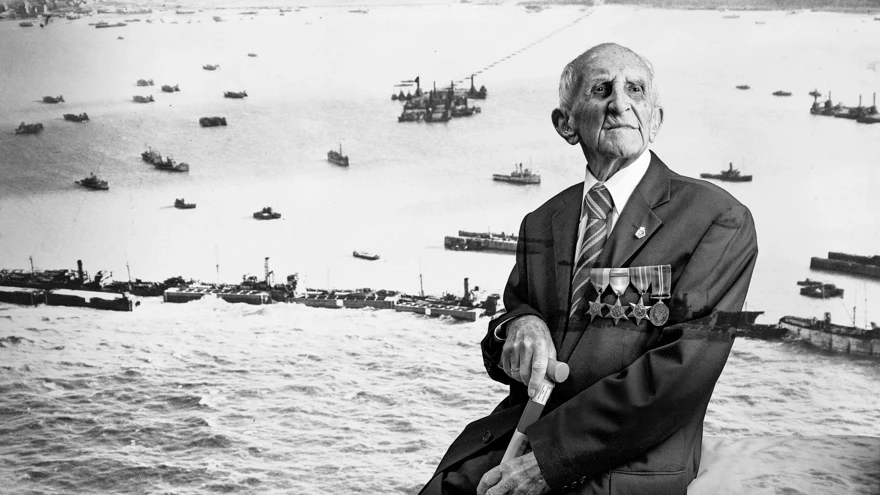
Image description
D-Day veteran Joe sits for his portrait with four medals displayed on his breast, he’s looking off into the distance as though sitting on a harbour looking out to the horizon. His portrait sits atop an aerial view of one of the Mulberry harbours where at the age of 19 Joe served on HMS Ryde. The background is split in two by the harbour wall, rough seas in the foreground and the calm water of the harbour filled with ships much like the HMS Ryde. There is a sadness to the portrait as Joe is transported back to his memory of the brutal slaughter of American troops at Omaha due to unneutralised pillboxes manned by machine gunners. Joe's ship provided refuge for exhausted soldiers, offering comfort and support amidst the chaos. This juxtaposition of calm and chaos is reflected in the sea behind his portrait.
Bob, the gunner shooting down the enemy

Image description
Bob, 99, photographed 80 years after D-Day when he was a gunner in the Royal Navy aged just 19. He looks directly down the lens of the camera at us as his numerous medals shine on his chest. In the background is an image of British and US forces manning 20mm gun positions on board USS LST-25 watching landing craft head towards Gold assault area on 6 June 1944. The photograph highlights the importance of each cog in the machine, each man with his position and his personal duties to attend to, surrounded by other vessels each filled with other individuals doing the same. Bob successfully shot down an enemy plane, boosting morale amongst the troops. Bob bid farewell to the American soldiers as they got into the transporter, worrying about one who stood out with an English helmet. He never learned their fate, leaving a lasting memory.
Thomas served on a 'floating bomb'

Image description
Thomas, 98, served on a Landing Barge Oiler, converting it into an oil tanker for D-Day. He is photographed looking directly at the audience, as though making eye contact with each onlooker. His six medals are highlighted across his chest along with his Blind Veterans UK badges as symbols of his bravery and resilience throughout his long life. He stands in front of an aerial photograph of Allied naval craft off Dog and Easy beaches, Omaha assault area, taken on D-Day. The image encapsulates the magnitude of the horrors that Thomas and his comrades endured, a scattering of vessels and debris dotted about the vast shoreline. Thomas witnessed the aftermath of the invasion, including retrieving bodies from the water and observing the massive naval and aerial operations. His experience left a lasting impact, hoping no future generations would endure similar horrors.
Code breaker Peggy was a Royal Navy linguist
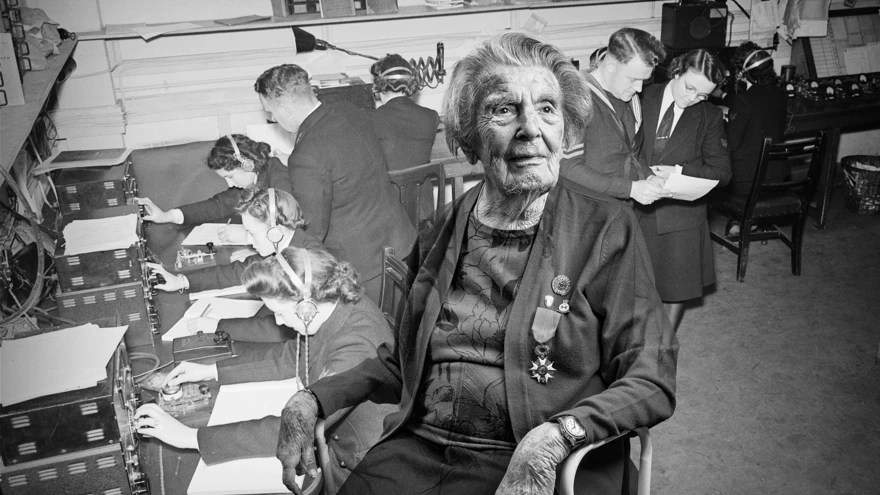
Image description
Peggy, D-Day code breaker, aged 102, is pictured seated, Legion D'Honneur proudly adorning her chest as she looks off to the distance. Her portrait is overlayed onto an image of WRENS at work in a corner of the Wireless/Telegraphs Room, in Rosyth, 1944. She still fits in perfectly to her surroundings, the bustle of code breakers at work around her. She worked as a linguist for the Women’s Royal Naval Service, intercepting and translating German radio traffic. Stationed in a solitary direction-finding tower, she spent nights transcribing codes without understanding their significance. On June 5, it was clear that a major operation was imminent, though Peggy and her peers were kept in the dark. This portrait highlights the invaluable work of those on the home front, her unassuming presence reflects her time doing the hidden work that contributed so greatly to victory.
George was a torpedo boat gunner
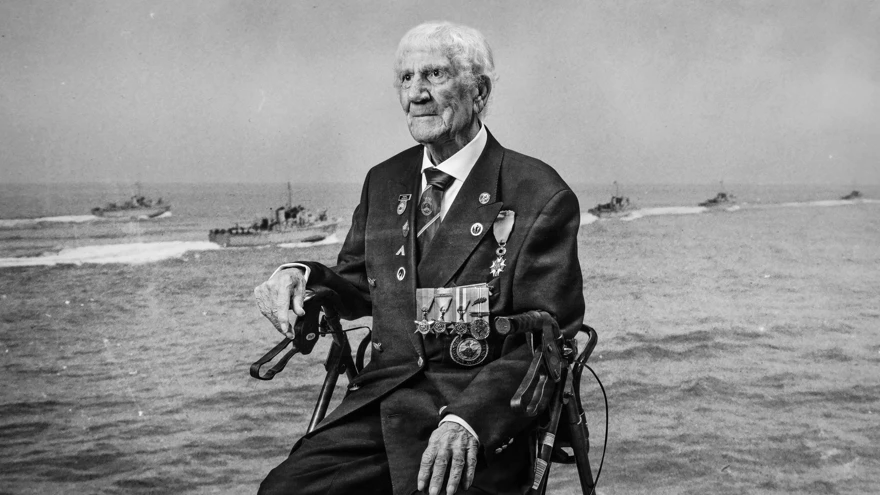
Image description
George, 99-year-old D-Day veteran sits pensively, adorned with medals, on his walker at the centre of the photograph. He looks out to the left as if he is seeing something that the audience are not. Perhaps a memory of the day, the massive bombardment by Allied battleships and cruisers or of witnessing the tragic navigation error that led to the slaughter of American troops landing too far west. His stoic portrait overlays a photograph taken from George’s boat at around 7am on D-Day. The calm before the storm captured in time, with its witness who knows all that is to come looking on from the future.
Alec: mine sweeper and defender of his comrades

Image description
Portrait photograph of Alec, D-Day veteran, adorned in medals and beret. He sits with sight loss glasses in hand, his medals reflect his resilience both as a teen at war and in his later journey with sight loss. Alec looks wistfully into the distance as though remembering the sounds of battle on D-Day from below the waterline on aircraft carrier HMS Campania. His striking portrait overlays a 1944 photograph of a crashed Fairey Fulmar fighter aircraft taken from the deck of his ship shortly after D-Day, as though captured from his own memory. Alec served on the aircraft carrier HMS Campania, sweeping mines and detecting U-boats during the D-Day invasion.
By land: Meet our D-Day Army veterans
Desert rat John avoided mines on Gold Beach

Image description
103 year old D-Day veteran John is pictured in a blazer, with a beret and Blind Veterans UK badge proudly displayed. He looks straight down the lens as if standing in the pictured background asking the viewer to see him. Behind him you see tanks and equipment being unloaded on the invasion beaches in Normandy with barrage balloons scattered in the sky above. Balancing the composition with John to the right is a tank moving along the beach. John served with the Desert Rats - 7th Armoured Division during the Normandy landings. His unit navigated their vehicles through mine-cleared lanes under fire onto Gold Beach. As an instrument mechanic with the Royal Electrical and Mechanical Engineers, John maintained vital equipment for his division, he is aptly photographed here surrounded by his machines.
Raymond: The bomb disarmament specialist
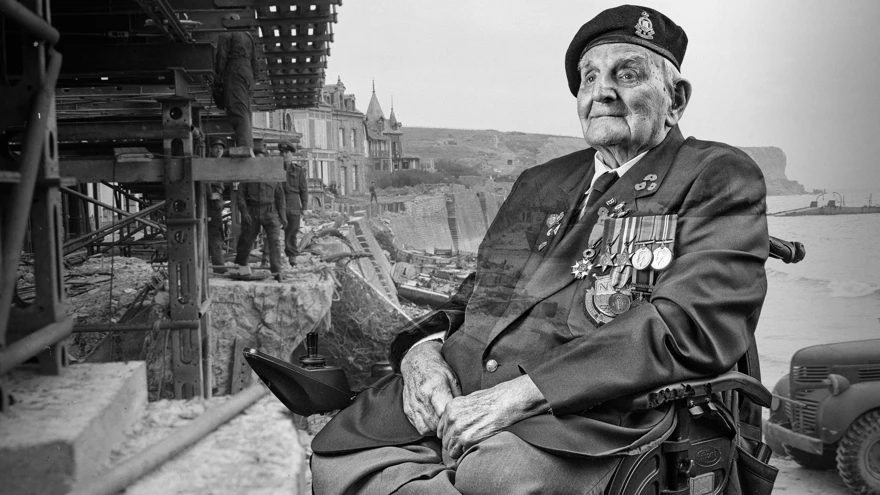
Image description
Photographed in his centenary year, Raymond, D-Day veteran of the Royal Army Ordnance Corps is pictured in full military regalia. He sits in his wheelchair, numerous medals presented on his breast, as he looks out to the left, as though remembering that day 80 years ago, as though he is looking at and admiring the men in the background photo. His portrait is set against an image that shows the wreckage of one of the Mulberry harbours in Arromanches after a storm. Landing in Arromanches a few days after D-Day, his unit faced fierce resistance as the town hadn’t yet been taken by the Allies. It took three days of intense fighting to clear out the entrenched German forces.
Richard stormed Sword Beach in an armoured tank
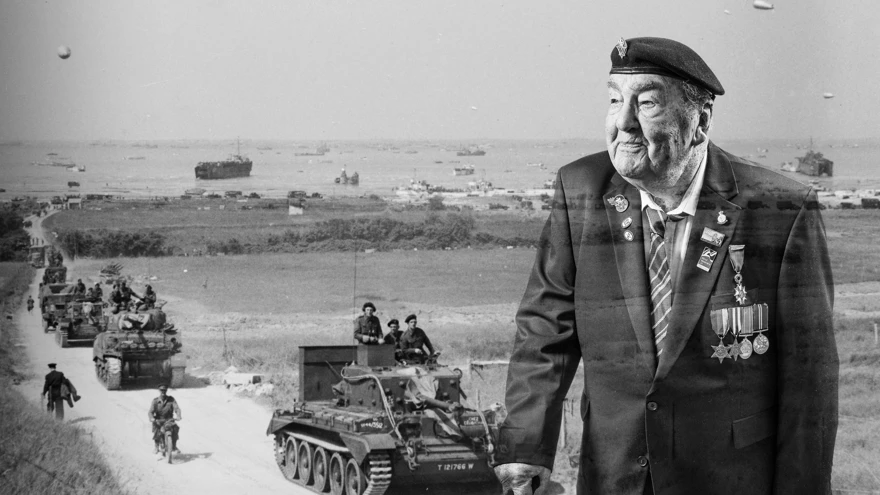
Image description
Richard is a D-Day veteran tank driver from the Royal Armoured Corps. He stands tall in his beret and medals, looking out over the scenes of the background image as though watching over them from the future. This portrait is overlayed on a photograph of a Cromwell Mk V tank leading a column of armour and soft skin vehicles inland from the beaches. The scene is a chaotic one that highlights the offensive from sea, land and air with tanks, ships and aircraft all captured in one powerful image. Richard landed on Sword Beach via one of the Mulberry harbours. His tank unit replaced others decimated by German forces. Richard recalls the cramped, unsanitary conditions inside the tanks and the horrors of war, including suffering livestock and the stench of death.
Harry was leading the charge at Sword Beach
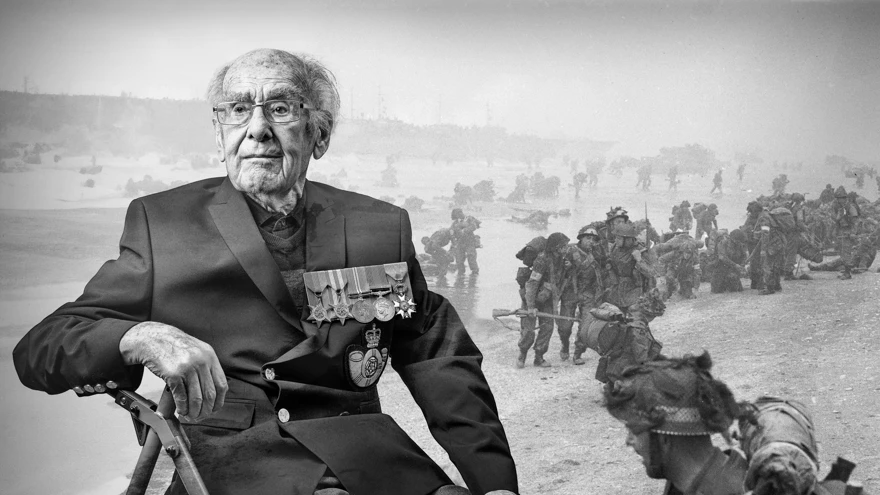
Image description
Harry was a D-Day veteran of the King’s Shropshire Light Infantry. He is pictured seated on his walker, one arm resting on the arm of his mobility aid. His impressive array of medals stand out at the centre of the composition as he looks directly to the audience. Harry was one of many who jumped from landing craft into the cold water that day, he narrowly escaped drowning when the ramp dug into the seabed, pulling him underwater until he was rescued. His portrait sits atop an image of Allied troops landing on Sword Beach at around 8:45am on D-Day, Harry being just one incredible troop of thousands that day. His battalion destroyed a German gun battery, helping secure the beach despite heavy casualties, looking at the detail in the background you see that this photograph is littered with those casualties. Harry sadly passed away on 17 April 2024, aged 102.
Bill dodged enemy fire to survive the landing

Image description
Bill is photographed in his centenary year, having been 20 years old on D-Day. He sits to the left of the composition, medals shining against his dark suit as he looks off to the right, as if reflecting on himself on this day 80 years ago. His portrait sits on a background image of Allied troops making their way inland with their equipment including a motorcycle and handcarts at Saint-Aubin-Sur-Mer on D-Day. A driver in the Royal Army Service Corps, he was attached to the 11th Armoured Division. Upon landing, he witnessed the devastation on the beach, including the destruction of his regiment. As a motorcyclist, Bill navigated burning beaches and German defences.
Ken prepared the vehicles for action and stormed the beaches
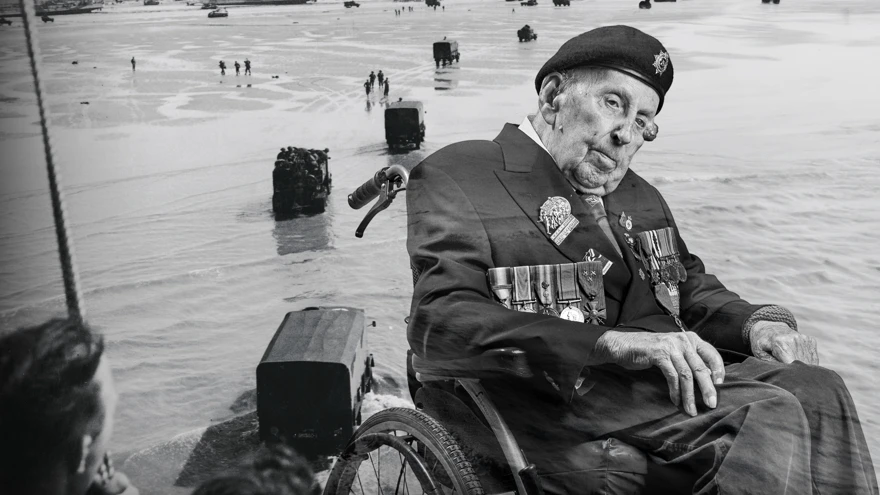
Image description
Ken was a D-Day veteran mechanic with the Royal Army Service Corps, he is pictured in military regalia, his medals and his fathers’ medals proudly worn across his chest. The portrait reflects time passing over 80 years, at the time of the photo Ken was 101 years old and pictured in his wheelchair, at odds with the background image showing lorries disembarking from a tank landing ship off the Normandy beaches. He played a crucial role in waterproofing the lorries they drove onto Sword Beach at 7:30am. Amidst heavy fire and chaos, he managed to drive ashore and encountered a welcoming Frenchman at the top of the beach. Ken was among the first to receive the Legion d'Honneur, the highest French order of merit. Ken sadly passed away on 16 April 2024, aged 101.
George's second flotilla triumph

Image description
George is another of our Centenary D-Day veterans, he served in the Royal Electrical and Mechanical Engineers, carrying ammunition. He is photographed in tartan trousers and a jacket bearing a skull and cross bones, he is a striking figure. Part of the second flotilla, he landed on Jig Beach and waited under fire for the order to advance. The background image shows Allied forces coming ashore on D-Day from landing craft assault on Jig Green beach, Gold area. George assisted in carrying the wounded and dead, witnessing the true horror of war. Soldiers run by him as though frozen in time whilst George has grown to the age of 100.
By air: Meet our D-Day RAF veterans
John: Guiding wings in the RAF’s 143 Squadron
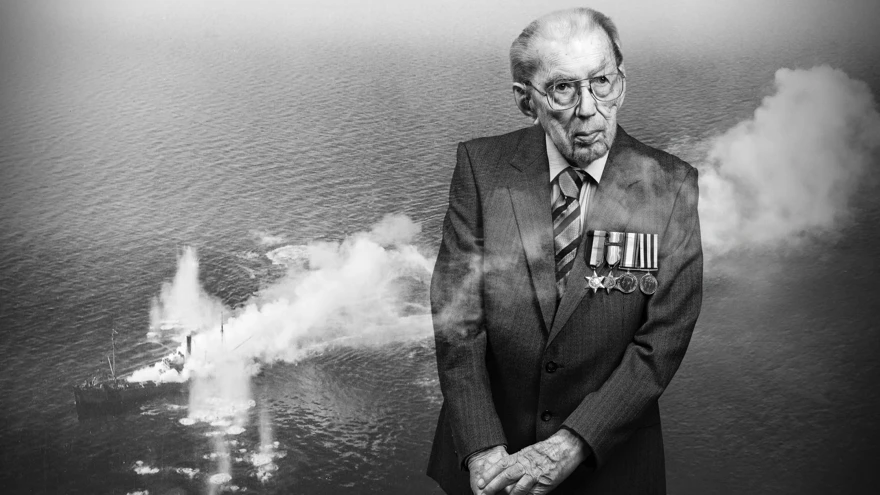
Image description
D-Day veteran John is photographed standing on the right of the composition with four medals displayed proudly on his breast. At 101 years old, he stands tall, the only marker of his age being his cane. The backdrop is filled with a vast expanse of ocean and a single German iron ore carrier under attack. Great plumes of smoke from the past seep into the present as they encompass John’s portrait. This image was taken from John’s Mosquito aircraft in January 1945 and gives a visceral idea of what John may have seen on D-Day when his squadron patrolled the English Channel targeting German E-boats to protect the Allied troops.
Syd aimed high as an operations air gunner
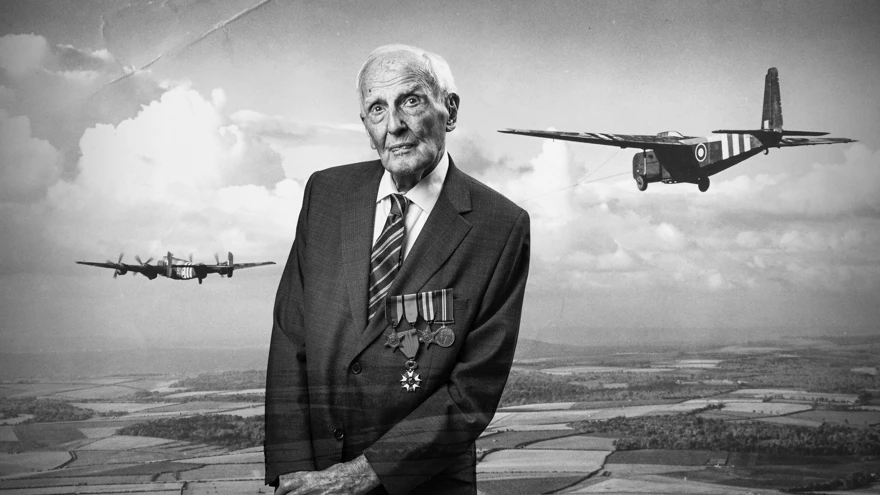
Image description
Reflecting from 21 to 101, D-Day veteran Syd is captured in his 101st year looking towards the audience in a confronting composition. As Syd stands proudly with his medals on his chest, his past flies by him. As a gunner in the RAF with 644 Squadron Syd flew Halifax bombers and towed gliders, on D-Day Syd recalls seeing the vast array of landing crafts stretching across the English Channel, likening it to a guards parade. The photograph in the background of the composition shows a Halifax bomber towing a Horsa glider, exactly as Syd had done surrounded by thousands of others on that June morning.
Harry was a pilot officer, bringing home the walking wounded

Image description
Harry, 103, D-Day veteran is photographed seated to the right of the composition, looking out towards the left, a half-smile across his face. As a pilot with the second tactical Air Force 84 Group Harry saw D-Day from the air. His portrait is set against such a view taken on D-Day, of the junction of King Red and King Green beaches, Gold assault area, during the landing of the 50th Infantry Division. Much of D-Day from Harry’s point of view was fought thousands of feet below him, he praised the Royal Engineers for their landing strips, which facilitated his transportation of senior army officers to Normandy and brought back the walking wounded to Tangmere where ambulances were waiting.
Today these D-Day veterans are still battling, only now their enemy is sight loss.
Please donate to our D-Day 80 commemorative appeal, so these brave veterans can have the support and equipment they need to live the life they choose.
Read more
Our D-Day Navy veterans
Thomas, Joe and Bob were just teenagers when they crossed the channel on ships providing vital defence support.

Our D-Day Army veterans
Harry, John and Richard were amongst the 150,000 brave soldiers who risked their lives on the beaches of Normandy.

Our D-Day RAF veterans
Syd, Harry and John played crucial roles in the invasion from the air and will never forget their experiences.

Sign up for email updates
We would love to send you updates about our work and how you can support us.
You can change your contact preferences at any time by calling us on 0300 111 2233 or emailing us. See our privacy policy for more details.
